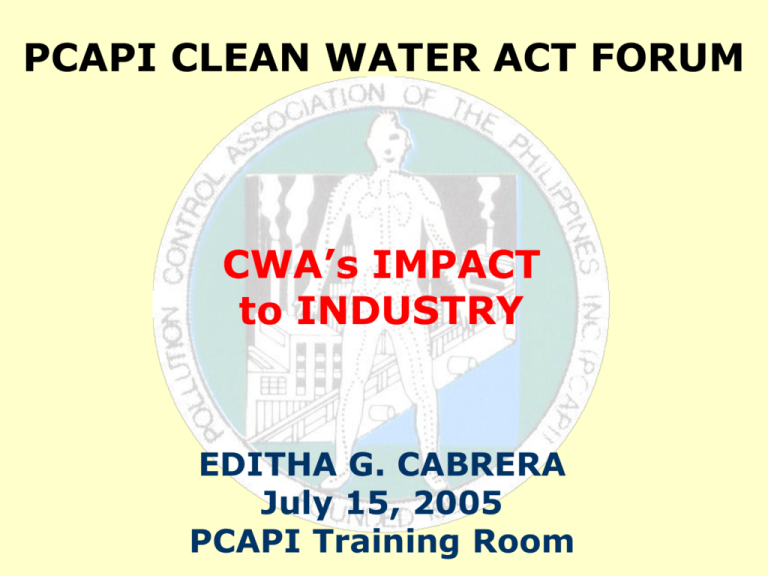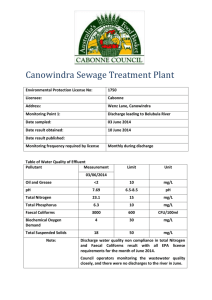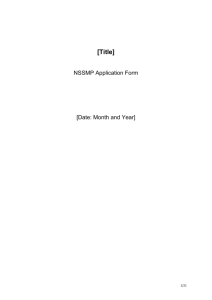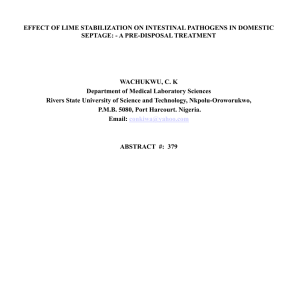cascade2
advertisement

PCAPI CLEAN WATER ACT FORUM CWA’s IMPACT to INDUSTRY EDITHA G. CABRERA July 15, 2005 PCAPI Training Room Timelines RA 9275 (CWA) – signed on March 22, 2004, published April 21, took effect May 6, 2004 DAO 2005-10 (CWA IRR) – signed on May 16, 2005, published May 26 and took effect June 10, 2005 Discharge Fee implemented June 10, 2005. National Sewerage and Septage Management Program by June 2005 Non-attainment area to be designated Nov 2005, and an improvement plan six months after. Industry specific standard by May 2006 National Water Quality Status Report by May 2006 Deadline for connecting domestic ww of industries to existing WWTF on June 2006 CONCEPTUAL FRAMEWORK Integrated Water Quality Improvement. Framework Water Quality Mgt. Action Plan (WQMAP) LGU Compliance Plan (CP) WQMAP LGU CP WQMAP LGU CP Joint Oversight Congressional Committee Natl. Septage/ Sewerage Mgt. Classification/ Reclassification Groundwater Vulnerability Mapping WQ Guidelines/ Criteria Effluent Standards Categorization of Industry Wastewater Charge System Discharge Permits Financial Liability Programmatic EIA Incentives Prohibitions/Sanctions/Actions SALIENT POINTS SOURCES TREATMENT MODE OF DISPOSAL REGULATION Point Sources Industrial ww inc. from water treatment plant WW Treatment Plt/ Sewage Treatment Plt Water Bodies one year Industrial domestic Land Disposal PSES or PSNS Domestic from establishments and household in HUCs Septic Tank Domestic from Non HUC Septic Tank Non-Point Sources Agricultural activities Aquaculture activities Centralized Sewage Treatment Plant “Irrigation” –subject to DA guidelines Offshore Sewage Treatment Plant Water Bodies • Discharge Fee (BOD/TSS) • Industry Specific Standard (DAO 35 in the interim) • Discharge Permit • Effluent trading except in non-attainment area • Discharge Fee [fix (?) until standards are set] • Standard based on DA guidelines • Discharge Permit ++ • Discharge Fee (BOD/TSS) • Standard in marine waters • PCG to enforce standard LGU Septage Mgt System, • LGUs may regulate sale, application and disposal of agricultural inputs • Guidelines for the prevention, control and abatement Others - Only when centralized STP is available Salient Points Water Quality Management Area – LGUs w/ common interest or development programs, projects, or problems – Governed by Governing Board (composed of LGUs, NGAs, civil society, water/utility & business sector) w/ Technical Secretariat – Laguna Lake under LLDA as one WQMA – Composed of LGUs w/ similar geographic, meteorological, conditions, etc.; – GB – Formulate strategies to coordinate policies for implementing CWA. – Each WQMA will have its own multi-sectoral group to establish and conduct WQ surveillance & monitoring network. The group shall report to GB. Salient Points Water Quality Management Area – Impact to Operation • Will separately create monitoring body (multisectoral group) • May institute more strict effluent standard than general standard – Possible Participation • Non govt members to be designated 6 mos after designation of WQMA through sectoral assemblies Salient Points Non-attainment Area – To be designated by November 2005 – DENR to develop action plan by May 2006 • May result to a more stringent effluent standard – New sources (includes expansion of existing) • Allowed only if total WQMA loading rate is reduced • Shall install LAER to be approved by Bureau • Discharge Fee subject to 20% surcharge (for the additional BOD load only) • Effluent averaging and trading not allowed National Sewerage & Septage Management Program A priority listing of sewerage, septage and combined systems/project for LGUs based on relevant considerations for the protection of water quality LGUs may enter into BOT or joint venture agreement w/ private sector for constructing, rehabilitating and/or operation of such facilities Each LGU shall appropriate land, including right-of-way/ road access fro construction of sewage and septage treatment facilities. Salient Points Sewerage and Septage Management – National Sewerage and Septage Management Program by May 2005 • A priority listing of sewerage, septage and combined systems/project for LGUs based on relevant considerations for the protection of water quality • LGUs may enter into BOT or joint venture agreement w/ private sector for constructing, rehabilitating and/or operation of such facilities • Each LGU shall appropriate land, including right-of-way/ road access fro construction of sewage and septage treatment facilities. Salient Points Sewerage and Septage Management – Industries with domestic wastewater has one year phase-in period to restructure drainage system to connect to existing wwtf. (If there is no existing WWTF, measures should be done to comply to effluent standard) – Water service will be denied of those failing to connect to available sewerage system, permits withhold or ECC not issued Salient Points Sewerage and Septage Management – Domestic Sewage Collection, Treatment & Disposal • W/in 5 years • Subdivisions, condominiums, malls, hotels, public buildings, etc. in highly urbanized cities (HUCs) shall connect their sewage lines to available systems or utilize their own sewerage system • For non-HUCs, septage or combined sewerage-septage management systems to be employed • Said connection subject to service charges/fees • DOH to prepare appropriate guidelines Salient Points Discharge Fee – Fee = P5.00 /net Kg BOD or TSS • Kg BOD/yr = (BODeffluent – BODraw) x volume/d x days/yr – Includes discharges from domestic sources and water treatment plant – Took effect June 10, 2005 – Additional parameters will be included as basis of fee in the future – STP Operators will pay and allowed to collect from each generators Salient Points Discharge Permit – Industries without DP will be given one year to secure • Those without industrial ww (thus no Permit to Operate) will have to secure DP for domestic ww (and meet effluent standard) • Requirements among others include ECC or CNC – DP shall be valid for a maximum of 5 years; longer if part of incentive of DENR program – Industries with disapproved or revoked DP should cease to discharge or be issued CDO – Effluent quota allocation will be implemented – Effluent trading may be allowed per management area PERMIT FEE Specifies quantity and quality of effluent (should not exceed standards) Source of NWQMF Maximum of 3 yrs effectivity Volumetric Rate of Discharge Annual Annual Fee Fee (PhP) (PhP) W/O Metals W/ Metals < 10 2,000 2,600 >10 – 30 2,200 2,800 >30 - 100 2,500 3,100 >100 - 150 2,700 3,300 >150 3,300 3,900 Salient Points WWTF breakdown – Considered breakdown if exceedance is >10% standard – Should be reported within 24 hrs, cease to discharge or be slapped maximum penalty of P200,000/day (discourages voluntary reporting of breakdown) Salient Points Discharge Permit for Irrigation (agricultural purposes) – Subject initially to fixed permit fee, then to variable fee when standard is established – Granted provided • Agricultural land is owned or covered with agreement • ww contains no toxic or hazardous material • Will not seep to ground water or contaminate nearby water body • Certification from DA re\ quality, quantity and distribution is suited for agricultural purposes • Only during periods of low surface water flow • Monitoring well for baseline and continuous monitoring • Submission of emergency plan Salient Points Others – Penalty will range from P10,000 to P200,000 per day to be increased by 10% every 2 years (Starting May 2006) – Gross violation (5 violations in 2 years) will be penalized P500,000 to P3,000,000 per day. – There will be a system for accreditation of laboratories – All water bodies shall be classified by June 2010 – Incentives and Rewards will be available – PAB powers remain – PD 984 is totally repealed – Plant abandonment shall include clean-up operations to prevent or remove pollution Position Paper Issues Discharge fee should be based on BOD or TSS and not BOD and TSS P100,000 cap Surcharge on Discharge Fee in non-attainment area (reduced to 20% from 50%) Surcharge on penalties in non-attainment area (No additional penalty) WWTF breakdown – no doubling of penalty – Clarification on breakdown (beyond 10% exceedance of standard) – No immediate cessation of discharge (but penalty will commence immediately) Position Paper Issues New sources to be allowed in nonattainment area, granted provided: – There is reduction in overall pollution loading of criteria pollutant not attained – LAER approved by Bureau is installed – Discharge fee is 20% higher All domestic wastewater of industry should be treated like household waste





